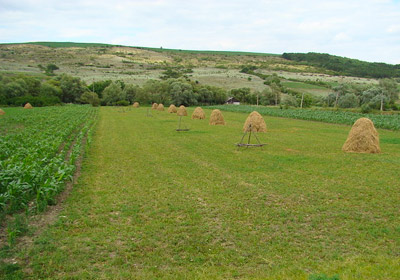Eastern Hills of Cluj, Romania

Eastern Hills of Cluj, Romania (© wikipedia, Țetcu Mircea Rareș)
The Eastern Hills of Cluj, Romania, are part of the Natura 2000 network.
The area includes a series of ridges with semi-natural pastures and meadows, associated arable land and orchards. Outstanding biodiversity is associated with traditional farmed habitats and farming practices, such as large-scale shepherded systems.
The area hosts a range of agri-environment options. Good understanding of current land use and trends, fruitful links among local community, grassroots NGO, and researchers, as well as successful grassroots projects characterize this area that struggle to find ways for long-term sustainability.
For more information on the HNV farming systems, challenges and innovations, see the innovations page of Eastern Hills of Cluj.
More info: www.efncp.org/hnv-showcases/romanian-carpathian-mountains/
Contact person:
Participatory approach
HNV-Link project started in the Learning Area (LA) with only limited information concerning the challenges of the extensive farming practices and of the rural communities. The Nature 2000 management plan for Natura 2000 site Dealurile Clujului (2015) had the only good environmental assessment. Prior academic research and work by NGOs identified the importance of permanent grasslands in preserving local biodiversity, and this role was acknowledged in public policies through a special agri-environment payment. However, the rest of the communities were left outside similar assessments, even though the Natura 2000 covers only one third of the LA’s territory and population. Also an integrated social, economic, and agri-environmental assessments of the LA were mainly missing.
Therefore, in HNV-Link, considerable effort was devoted to building a comprehensive assessment of all dimensions of the sustainable development of the territory. This was done to identify and to explain the main trends for the future of the HNV system in the LA.
The team engaged all key local actors in several participatory meetings, focus groups and seminars. It ran interviews with: farmersˈ associations (Somes Aries Cooperative for cattle breeders, Someșeana Association for sheep breeders, AgroTransilvania Cluster for food industry and farmers); Local Action Group Someș Transilvan; mayors or local council members from all communes of the LA (Apahida, Bonțida, Borșa, Chinteni, Dăbâca, Jucu, Panticeu and Vultureni); and NGOs (such as Lepideptorological Association – Custodian of the Natura 2000 area, Civitas NGO and others). Together LAG Somes Transilvan, the project team organized workshops in all eight communes to present existing opportunities for the HNV farming practices in the LAG development strategy. It conducted a field study based on the questionnaire to better understand the level of knowledge and perception of the HNV farming. A total of 132 respondents representing farmers, employees in the rural communities, members of the local households, NGOs, non-agricultural business, food-industry, local politicians, took part. Results showed that 76 % of the participants are aware of HNV farming. However, awareness was lower in the remote communes, which host the most valuable farmland in the Natura 2000 site.
Though time-consuming, the process was essential in building a sound Baseline Assessment and preparing the vision for HNV farming in the LA. As a culmination event, the team organised an innovation seminar to refine the vision for HNV farming with the actors and to decide on the innovation priorities for the next phase of the project.
After groundwork above, the team organised a regional meeting – "The Future of High Nature Value farming in Romania” in April 2018. The meeting was part of the AGRARIA Fair - the biggest agrifood fair in the country. Among the invited speakers were representatives of the European Commission (EIP Agri), Romanian ministries (Agriculture and Rural Development; Forestry and Water), Government Representative - Prefect of Cluj County, Local Action Group Somes, Transilvanian farmers, NGOs, consultants, researchers and students. Some presentations available at econ.usamvcluj.ro/cercetare/proiecte-de-cercetare/hnv-link-2/. Over 100 people attended the conference on HNV farming, and many more visitors of the AGRARIA Fair got to hear about the HNV farmland.
Finally, the project team established an Operational Group (currently a farmer, two NGOs and the University of Agricultural Science and Veterinary Medicine Cluj-Napoca), which aims to link grazing on the permanent pastures with the quality of the final product. The group plans to apply for funds from the Romanian Rural Development Programme. Assuring the pre-financing requirement remains the main challenge.
| Activities | Date | Number of participants |
|---|---|---|
| Interviews | Oct 2016-Feb 2017 | 24 |
| Workshops | Jan and May 2017 | 80 |
| Field study | Jan and May 2017 | 130 |
| Innovation seminar | June 2017 | 24 |
Gallery
Video
Slideshow
Outputs
-
 Eastern Hills of Cluj, Romania LA
Eastern Hills of Cluj, Romania LA
- Baseline Assessment
- Report from the Innovation seminar
- Presentation Innovation Seminar (See also: Prezentare seminar inovare)
- Innovation report
- Participatory approach in Eastern Hills of Cluj, Romania
- Eastern Hills of Cluj, Romania, HNV-Link Final Conference (Poster)
- Action Plan
(April, 2019)The compilations of the respective reports from all project learning areas - Baseline Assessments, Reports from innovation seminars, and Compendium of Innovation - can be found in 'Outputs'. Reports from the Innovation seminars are in the national languages, all other materials are in English.






